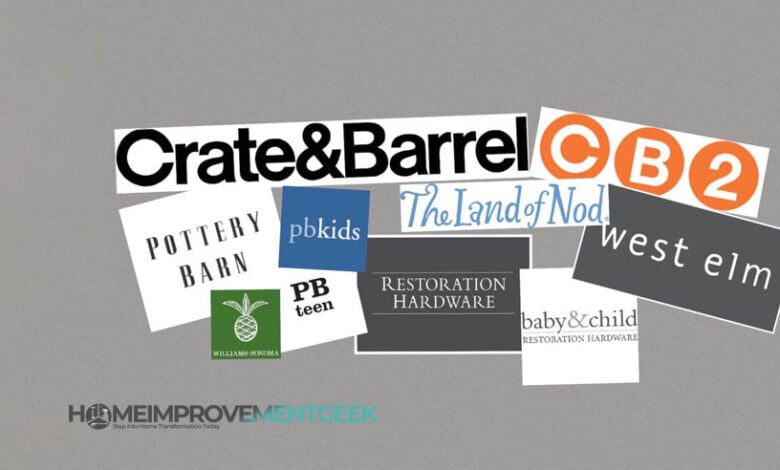West Elm vs. Crate and Barrel: Comparing Popular Furniture Retailers

Furnishing a home can be an exciting yet daunting task. With so many options to choose from, it’s important to select pieces that reflect your style while standing the test of time. When it comes to modern furnishings with a focus on quality craftsmanship, two brands often top the list: West Elm and Crate and Barrel. But when comparing West Elm vs. Crate and Barrel, which retailer truly stands out?
A well-decorated home brings joy, comfort, and personality to the spaces where we laugh, love, and make memories. Thoughtfully chosen furniture shapes the look and feel of each room, working cohesively to create an aesthetic that reflects the people who live there. With an abundance of retailers selling home furnishings, comparison shopping helps ensure you select pieces that align with your budget, lifestyle, and design sensibilities.
West Elm and Crate and Barrel rank among the most prominent modern furniture stores operating today. Both brands offer a diverse range of stylish, high-quality furnishings and décor at approachable price points. Keep reading to discover how West Elm and Crate and Barrel measure up across critical categories when it comes to aesthetics, variety, affordability, target demographics, policies, and beyond.
Background on West Elm and Crate and Barrel
To better grasp how West Elm and Crate and Barrel differ, it helps to understand their origins and evolutions.
West Elm
Founded in Brooklyn in 2002, West Elm brings a hip, contemporary edge to home furnishings. As part of Williams-Sonoma Inc.’s portfolio of brands, West Elm combines accessible luxury with an urban, modern perspective.
Beyond its 100+ U.S. and international retail locations, West Elm’s popular e-commerce site extends its reach globally. The brand offers an ever-evolving selection of living room seating, bedroom furniture, office collections, kitchen and dining pieces, outdoor items, décor, accessories, and more. By blending mid-century and modern sensibilities with a touch of warmth, West Elm’s curated assortment features textural interest and natural materials for livable glamour.
Crate and Barrel
Since its inception in 1962, Crate and Barrel has focused on simple, sensible, high-quality home products offered at fair prices. Founders Gordon and Carole Segal traveled throughout Europe visiting factories and designers to discover furniture and housewares unavailable in America. By importing these well-designed, affordably priced finds into their Chicago-based warehouse store, an innovative new type of home retailer emerged.
What began as a converted elevator factory now encompasses over 100 locations across the U.S. and abroad alongside thriving e-commerce operations. Loyal fans applaud Crate and Barrel’s selection of furniture, kitchenware, decor, bedding, bath goods, and more that blend form, function, and lasting value. Its edited assortments feature timeless silhouettes realized through quality materials and interest piquing color combinations.
Both purveyors share common ground in their commitment to reasonable prices and selections that span essential rooms and products. However, when analyzing West Elm against Crate and Barrel, intriguing differences also emerge.
Pricing and Affordability
For many, cost plays a pivotal role when weighing any significant purchase. West Elm and Crate and Barrel lure customers with beautiful offerings across approachable price spectrums.
West Elm Pricing
A leader in modern luxury for less, West Elm positions itself one tier below premium-priced brands yet above mass retailers. While not the least expensive option, West Elm conveys perceptible value vis-à-vis the quality, design, and uniqueness found in its broad assortment.
Customers can expect to invest a bit more in West Elm furnishings compared to mass merchants. However, its prices mostly undershoot the thresholds of true high-end players. By targeting the lower end of upscale shoppers, West Elm smartly appeals to modern sensibility budgets.
As with any retailer, pricing fluctuates across West Elm’s range. More intricate items like leather sofas or storage beds understandably exceed the budgets of college students or new grads furnishing their first apartment. Conversely, tables, rugs, and decor like pillows, throws, and artwork offer affordable avenues to inject West Elm’s signature style into one’s home.
Crate and Barrel Pricing
Since its early days, Crate and Barrel has staked its reputation on offering high-design products at realistic prices. Cost-conscious shoppers appreciate that its wares convey substance and style without draining their wallets.
Crate and Barrel positions its price bands toward the middle and lower end of high-end. For example, while its sofa or dining sets exceed mass merchant versions, Crate and Barrel pieces ring up significantly lower than luxury dealers. When contrasted with West Elm, Crate, and Barrel furnishes homes beautifully at similar or lesser price points in many categories.
Style and Design Aesthetic
While affordable pricing attracts shoppers, a retailer’s aesthetic keeps them coming back. Both brands exude definitive styles sought-after by modern dwellers.
West Elm Style
West Elm confidently touts its brand of warm modernism through a signature look one might describe as a “mid-century meetings urban loft.” Streamlined silhouettes interplay with reclaimed woods, cozy textiles, handcrafted ceramics, and global artisan details.
Neutral backdrops like layered ivories and camel contrast beautifully with tactile throws and rustic finishes. West Elm interiors feel curated for modern living yet comfortable and Livable.
Crate and Barrel Style
For Crate and Barrel, less is more as evidenced by its minimalist aesthetic spotlighting clean lines and intentional form. Crisp color juxtapositions add visual intrigue to uncomplicated, uncluttered profiles.
Signature Crate and Barrel style spotlights creative construction and natural, authentic materials. Understated modern and contemporary collections feature smooth woods, rich leathers, pure cotton, and unembellished metals. Neutral palettes allow texture and subtle tonal shifts to shine as focal points.
| West Elm Style | Crate and Barrel Style |
|---|---|
| Warm, approachable | Cool, pragmatic |
| Mid-century modern influences | Strictly contemporary |
| A mix of organic and industrial | Celebration of natural materials |
| Layers of texture | Tactile yet understated |
| Livably comfortable | Highly functional |
So while both brands exude modern minimalism, West Elm tends toward more rounded edges, layered materials, and darker tones while Crate and Barrel embraces sharp lines, unadorned finishes, and contrasting lights and darks.
Product Assortment
In addition to divergent design perspectives, West Elm and Crate and Barrel differ slightly in the scope of product offerings. Both carry the essentials, providing curated options for major rooms and categories. However unique flourishes set each apart.
West Elm Products
Browse West Elm’s site or stores and discover stylish finds for living, working, dining, sleeping, and lounging. Fine furnishings mingle with global accents and modern artwork to create complete looks.
Collections span :
- Sofas, sectionals, chairs
- Beds, mattresses, dressers
- Rugs, curtains, lighting
- Tables, storage, office
- Decor, pillows, throws
- Kitchen, dining, bar
- Bathroom furniture
- Outdoor, rugs, decor
Beyond the ordinary, part of West Elm’s allure lives in its extras. Find unique items like hanging chairs, convertible furniture, eclectic accessories, and statement lighting. Globally inspired handicrafts and specialty collaborations further individualize its assortment with artisanal details and customization options.
Crate and Barrel Products
Crate and Barrel takes a “less is more” approach to product mix. Without overextending into niche arenas, it focuses on perfecting basics over chasing trends. Thoughtful attention ensures its edited selections solve problems with flair whether building out a kitchen or decking out a dorm.
True to its identity, Crate and Barrel covers the essentials:
- Sofas, chairs, tables
- Beds, mattresses, dressers
- Kitchen, tabletop, and cookware
- Small appliances, laundry
- Rugs, lighting, decorative accents
- Bath fixtures and accessories
- Outdoor furniture
Rather than overdoing peripherals, Crate and Barrel prioritize refining and expanding core categories. So while assortment size trails West Elm’s abundance, offerings stay sharply curated to standard rooms and household needs.
Demographic Differences
While plenty of brand crossover exists, West Elm and Crate and Barrel appear to attract slightly distinct core consumer bases.
West Elm’s Customer Base
West Elm shoppers tend young, educated, and metropolitan. The brand holds particular appeal for urban apartment dwellers seeking stylish upgrades.
Its customer sweet spot lands between 25 and 44 years old. They appreciate West Elm’s modern designs yet warm, livable personality. Balancing style with a budget, this demographic sees West Elm as an aspirational step up from college futons without zapping all savings.
According to their 2021 annual report, West Elm users are 73% female, 78% have a college degree or higher, and 66% fall under age 44.
Crate and Barrel’s Customer Base
Crate and Barrel connects effectively with freshly minted adults seeking grown-up, yet practical furnishings. Its tailored displays attract young professionals transitioning from dorms to first apartments or couples settling into traditional family homes.
While West Elm users skew females, Crate and Barrel strikes a slightly better balance attracting both men and women. Clean lines and family-friendly functions lure suburban-minded shoppers looking to feather comfortable nests. They appreciate Crate and Barrel’s sensible outlook that doesn’t sacrifice intelligent design.
Return Policy Comparison
Mistakes happen, styles change, or pieces fail to spark joy once unpacked. When returns become necessary, West Elm and Crate and Barrel try to make the process hassle-free. Here’s how their refund policies compare:
West Elm Returns
Items purchased online or in West Elm stores qualify for return within 30 days of receipt provided they are unused with original packaging and hangtags.
Certain exclusions exist such as MTO (made to order), custom upholstery, or monogrammed items unless due to damage or defect. Clearance merchandise falls under a 14-day return policy.
West Elm issues refunds in the original form of payment. Shipping and return shipping costs (unless due to West Elm error) apply to customers.
Crate and Barrel Returns
For online orders, Crate and Barrel extend their return window to 90 days from the shipment date. In-store purchases must be returned within 30 days with a receipt.
Refunds apply to unused merchandise in original condition with packaging and tags. Custom designs follow more complex guidelines.
As with West Elm, customers pay return shipping on online returns unless caused by a Crate & Barrel mistake. Free returns apply on products damaged upon arrival. Gift returns follow expanded holiday guidelines.
Both retailers demonstrate reasonable, competitive policies allowing satisfactory windows for returns alongside normal exclusions protecting against abuse. Crate and Barrel edges ahead with its 90-day generosity.
The Final Takeaway
When comparing this iconic home retailer pairing, West Elm and Crate and Barrel both emerge as smart sources for contemporarily styled, well-made furnishings. They attract progressive shoppers seeking fashion-forward interiors conveying substance and uniqueness.
Beyond shared merits, distinctive differences give each brand character. West Elm charms through eclectic offerings, cozy finishes, and customizable potential. Meanwhile, Crate and Barrel win fans via ultra-practical pieces, unembellished aesthetics, and simplified scopes.
Neither outlet banks on ultra-luxury cachet or ultra-low pricing to lure audiences. Instead, smart shoppers select one or both brands knowing they deliver measurable value on modern design across approachable price brackets.
Whichever you choose when evaluating West Elm vs. Crate and Barrel, rest easy that their reputable, retail-tested collections will furnish happy homes for years to come.




